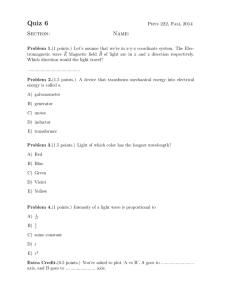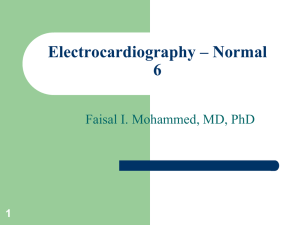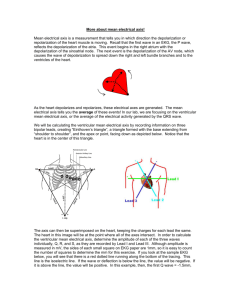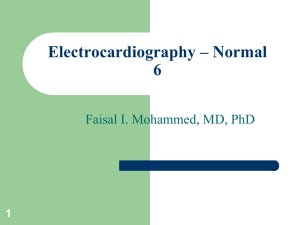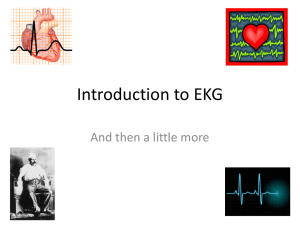ECG
advertisement
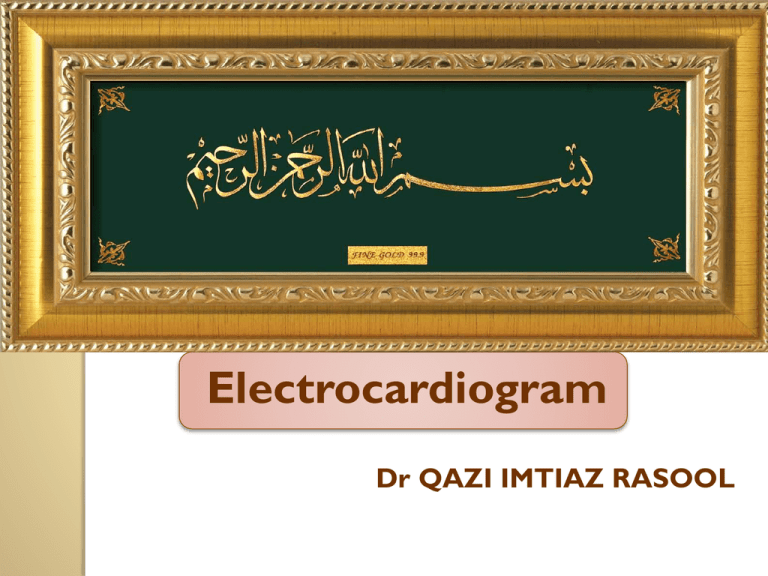
Electrocardiogram Dr QAZI IMTIAZ RASOOL OBJECTIVES 1. Define ECG and describe the characteristics (waves & intervals) of normal ECG. 2. Describe the significance of mean electrical axis of ventricular QRS. 3. Describe and explain the causes for abnormal ECG waves and intervals. Willem Einthoven Nobel prize in 1924 for electrocardiogram (discovered in 1903) What types of pathology can we identify and study from EKGs? 1. Cardiovascular system 2. Respiratory system 3. Renal system 4. GIT system 5. Nervous system 6. Endocrines system (ECG, EKG) The electrocardiogram (the k is from the German “kardio” for “heart”) Electrocardiography – Procedure of graphic recording the electrical activity myocardium during cardiac cycle. Electrocardiogram is a representation of the electrical events of the cardiac cycle. NOTE;-Electrocardiograms must be viewed in the context of demographics health histories, and other clinical test correlates. in BIOPHYSISCS 1.If the direction of current (positive ion) is towards positive pole will record a positive, if negative wave it will be recorded as negative deflection 2. If the direction of current is parallel to the lead axis it will record a maximum deflection and minimum if it is at right angle Electric field of the heart on the surface of the thorax, recorded by Augustus Waller (1887). . These indicate that the heart is a dipolar source having the positive and negative poles at (A) and (B), respectively. Depolarization and EKG 1. Positive/upward vs. Negative/downward inflection 2. “Wave of depolarization” = “wave of positive charge” 3. Wave of depolarization moving towards positive electrode = positive inflection 4. 12 leads – different views of the same electrical activity Waveforms and Intervals QRS Complex with Interval and Segment Measurements P wave 1. 2. 3. 4. 5. 6. The first wave on the ECG Represents atrial activation(depolarization) Smooth Duration is less than 0.12 sec Amplitude is less than 0.25 mV Upright inferiorly ◦ Pointy = P pulmonale (RA hypertrophy) ◦ Bifid = P mitrale (LA hypertrophy) PR interval 1. Start of P wave to start of QRS 2. Normal = 0.12-0.2s 3. Too short – can mean WPW syndrome (ie. an accessory pathway), or normal! 4. Too long –means AV block (heart block) 1st/2nd/3rd degree QRS Duration 0.12 seconds 1. -1st deflection , is negative (downward), is labeled the Q wave. 2. -1st positive (upright) deflection is labeled the R wave, 3. - 2nd negative deflection following an R wave is labeled an S wave. Q wave 1. First negative deflection 2. Normally very small in deflection 3. If prominent, consider infarction R Waves 1. R wave amplitude increases from V1-V4 or V5 2. Amplitude of 4-5 mm or < S Waves 1. Large in V1 and V2 then progressively smaller to V6 QRS complex 1. Should be <0.12s duration 2. >0.12s = BBB (either LBBB or RBBB) 3. ‘Pathological’ Q waves can mean a previous MI (? territory) 4. >25% size of subsequent complex 5. Q waves are allowed in V1, aVR and III ST segment 1. ST depression 1. Downsloping or horizontal = abnormal Ischaemia (coronary stenosis) 2. If lateral (V4-V6), consider LVH with ‘strain’ or digoxin (reverse tick sign) 2. ST elevation 1. Infarction (coronary occlusion) 2. Pericarditis (widespread) T wave Rounded symmetric 2. Follow direction of QRS except aVR and V1 3. Represents myocardial repolarization 1. 4. 5. 6. Peaked (hyperkalaemia or normal young man) Inverted/biphasic (ischaemia, previous infarct) Small (hypokalaemia) QT interval 1. Start of QRS to end of T wave 2. Needs to be corrected for HR 3. Various formulae ◦ eg. Bazett’s: Long QT can be genetic (long QT sy.) or secondary eg. drugs (amiodarone, sotalol) Associated with risk of sudden death due to Torsades de Pointes Electrical = Mechanical activity P wave = atrial contraction 2. PR segment = allows time for blood to pass from atria to ventricles 3. QRS 1. 1. Shape based on direction/spread of depolarization 2. Duration 4. T wave = ventricular repolarization 1. Reverse order of depolarization 5. Atrial repolarization during QRS Depolarization and EKG 1. 2. 3. 4. 5. 6. 7. SA node – silent Atrial DP – P wave AV node – PR interval His bundle – PR interval Purkinje fibers – PR interval Ventricular depolarization – QRS complex Ventricular isoelectric period (initial – plateau of ventricular repolarization) – ST segment 8. Ventricular repolarization – T wave EKG Leads Leads are electrodes which measure the difference in electrical potential between two. 1. Two different points on the body (bipolar leads) 2. One point on the body and a virtual reference point with zero electrical potential, located in the center of the heart (unipolar leads) EKG Leads The standard EKG has 12 leads: 3 Standard Limb Leads 3 Augmented Limb Leads 6 Precordial Leads The axis of a particular lead represents the viewpoint from which it looks at the heart. II, III and AVF I and AVL V3 & v4 V5 & v6 Orientation of leads 1. Limb Leads: L2, aVF, L3: Inferior L1, aVL: Lateral aVR: Cavity 2. Chest Leads: V1, V2: Anterior V3, V4: Septal V5, V6: Lateral The Concept of a “Lead” RA Leads I, II, and III RA - - - LA + LA LEAD I LEAD III + LL Remember, the RL is always the ground +LL LEAD II Standard Limb Leads QRS Axis 1. QRS axis represents the net overall direction of the heart’s electrical activity. 2. Abnormalities of axis can hint at: Ventricular enlargement Conduction blocks (i.e. hemiblocks) Axis Coronal/frontal plane Normal axis is about 60 degrees LAD = axis < -30 degrees RAD= axis > 90 degrees QRS Axis By near-consensus, the normal QRS axis is defined as ranging from -30° to +110°. -30° to -90° is referred to as a left axis deviation (LAD) +110° to +180° is referred to as a right axis deviation (RAD) Determining the Axis - Quadrant Approach - Equiphasic Approach Predominantly Positive Predominantly Negative Equiphasic Axis LEAD L1 LEAD aVF NORMAL POSITIVE POSITIVE RAD NEGATIVE POSITIVE LAD POSITIVE NEGATIVE INDETERMINATE NEGATIVE NEGATIVE Equiphasic Approach 1. Determine which lead contains the most equiphasic QRS complex. 2. The fact that the QRS complex in this lead is equally positive and negative indicates that the net electrical vector (i.e. overall QRS axis) is perpendicular to the axis of this particular lead. EXAMPLES :_ 1. Sinus rhythm ECGs, Normal and Abnormal P wave VPC+APC Sinus bradycardia (lead III). Prolonged P-R interval caused by first degree heart block (lead II) Complete AV block Atrial tachycardia with 2:1 conduction Ventricular preexcitation (WPW) Arrhythmia: conduction failure at AV node No pumping action occurs STOKES ADAMS SYNDROME •Seen during acute complete AV block•Ventricles stop beating due overdrivesuppression•Person faints due reduced blood supply tobrain•Ventricle recovers after few seconds &starts generating own impulses•Rxartificial pacemaker ECG Changes : Ischemia 1. 2. 3. 4. T-wave inversion ( flipped T) ST segment depression T wave flattening Biphasic T-waves Baseline 2004 Anna Story 45 ECG Changes: Injury 1. 2. 3. ST segment elevation of greater than 1mm in at least 2 contiguous leads Heightened or peaked T waves Directly related to portions of myocardium rendered electrically inactive Baseline 2004 Anna Story 46 ECG Changes: Infarct 1. 2. 3. Significant Q-wave where none previously existed 1. Why? 1. Impulse traveling away from the positive lead 2. Necrotic tissue is electrically dead No Q-wave in Subendocardial infarcts 1. Why? 1. Not full thickness dead tissue 2. But will see a ST depression 3. Often a precursor to full thickness MI Criteria 1. Depth of Q wave should be 25% the height of the R wave 2. Width of Q wave is 0.04 secs 3. Diminished height of the R wave 2004 Anna Story 47 Evolving MI and Hallmarks of AMI Q wave ST Elevation 1 year 2004 Anna Story T wave inversion 48
